Beam Profile Characterisation of an Optoelectronic Silicon Lens-Integrated PIN-PD Emitter between 100 GHz and 1 THz
Abstract
:Featured Application
Abstract
1. Introduction
2. Materials and Methods
3. Results
3.1. Power Measurements
3.2. Beam Profiles
3.3. Experimental Considerations
3.3.1. Near Field vs. Far Field
3.3.2. Dependence of Beam Profile on Distance from Detector
3.3.3. Angular Resolution
- When narrow features are added to the curve (Figure 8c–f), then angular resolutions greater than the width of the feature (FWHM < θres) cause broadening and flattening of the feature.
3.3.4. Standing Waves
3.3.5. Repeatability of Measurements
4. Discussion
5. Conclusions
Author Contributions
Funding
Data Availability Statement
Conflicts of Interest
References
- Preu, S.; Döhler, G.H.; Malzer, S.; Wang, L.J.; Gossard, A.C. Tunable, continuous-wave Terahertz photomixer sources and applications. J. Appl. Phys. 2011, 109, 061301. [Google Scholar] [CrossRef] [Green Version]
- Wei, L.; Yu, L.; Jiaoqi, H.; GuoRong, H.; Zhang, Y.; Fu, W. Application of terahertz spectroscopy in biomolecule detection. Front. Lab. Med. 2018, 2, 127–133. [Google Scholar] [CrossRef]
- Yang, X.; Zhao, X.; Yang, K.; Liu, Y.; Liu, Y.; Fu, W.; Luo, Y. Biomedical Applications of Terahertz Spectroscopy and Imaging. Trends Biotechnol. 2016, 34, 810–824. [Google Scholar] [CrossRef] [PubMed]
- Zimdars, D.; White, J.S. Terahertz reflection imaging for package and personnel inspection. Def. Secur. 2004, 5411, 78–83. [Google Scholar] [CrossRef]
- Tsydynzhapov, G.E.; Gusikhin, P.A.; Muravev, V.M.; Andreev, I.V.; Kukushkin, I.V. New terahertz security body scanner. In Proceedings of the 2018 43rd International Conference on Infrared, Millimeter, and Terahertz Waves (IRMMW-THz), Nagoya, Japan, 9–14 September 2018; p. 1. [Google Scholar] [CrossRef]
- Trontelj, J.; Sešek, A. Electronic terahertz imaging for security applications. In Proceedings of the SPIE 9747, Terahertz, RF, Millimeter, and Submillimeter-Wave Technology and Applications IX, San Francisco, CA, USA, 13–18 February 2016; p. 974713. [Google Scholar] [CrossRef]
- Zhong, S. Progress in terahertz nondestructive testing: A review. Front. Mech. Eng. 2019, 14, 273–281. [Google Scholar] [CrossRef]
- Cosentino, A. Terahertz and Cultural Heritage Science: Examination of Art and Archaeology. Technology 2016, 4, 6. [Google Scholar] [CrossRef]
- Stuebling, E.-M.; Staats, N.-A.; Globisch, B.; Schell, M.; Portsteffen, H.D.; Koch, M. Investigating the layer structure and insect tunneling on a wooden putto using robotic-based THz tomography. IEEE Trans. Terahertz Sci. Technologies 2020, 10, 1. [Google Scholar] [CrossRef]
- Castro, C.; Nellen, S.; Elschner, R.; Sackey, I.; Emmerich, R.; Merkle, T.; Globisch, B.; De Felipe, D.; Schubert, C. 32 GBd 16QAM Wireless Transmission in the 300 GHz Band Using a PIN Diode for THz Upconversion. OFC 2019, M4F.5. [Google Scholar] [CrossRef]
- Ali, M.; Guzmán, R.C.; Cojocari, O.; Nellen, S.; Santamaría, G.; García-Muñoz, L.E.; Segovia-Vargas, D.; Globisch, B.; Carpintero, G. Quasi-Optic Transmitter and Receiver Modules Enabling Next-Generation Ultra-Broadband Wireless Links at Carrier-Wave Frequencies Ranging from 60 to 180 GHz. J. Infrared Millim. Terahertz Waves 2019, 40, 688–695. [Google Scholar] [CrossRef]
- Globisch, B.; Kohlhaas, R.B.; Liebermeister, L.; Schell, M.; Nellen, S. Recent progress of continuous-wave terahertz systems for spectroscopy, non-destructive testing, and telecommunication. In Proceedings of the Terahertz, RF, Millimeter, and Submillimeter-Wave Technology and Applications XI, San Francisco, CA, USA, 27 January–1 February 2018; Volume 10531, p. 105310C. [Google Scholar] [CrossRef]
- Liebermeister, L.; Nellen, S.; Kohlhaas, R.; Breuer, S.; Schell, M.; Globisch, B. Ultra-fast, High-Bandwidth Coherent cw THz Spectrometer for Non-destructive Testing. J. Infrared Millim. Terahertz Waves 2019, 40, 288–296. [Google Scholar] [CrossRef] [Green Version]
- Göbel, T.; Stanze, D.; Globisch, B.; Dietz, R.J.B.; Roehle, H.; Schell, M. Telecom technology based continuous wave terahertz photomixing system with 105 decibel signal-to-noise ratio and 35 terahertz bandwidth. Opt. Lett. 2013, 38, 4197–4199. [Google Scholar] [CrossRef] [PubMed]
- Nellen, S.; Globisch, B.; O’Gorman, J.; Anthur, A.; Vujicic, V.; Barry, L.P.; Schell, M. Fiber-coupled, photoconductive receiver for heterodyne detection up to 1 THz stabilized by an optical frequency comb. In Proceedings of the International Conference on Infrared, Millimeter, and Terahertz Waves, IRMMW-THz, Cancun, Mexico, 27 August–1 September 2017. [Google Scholar] [CrossRef]
- Olvera, A.F.; Lu, H.; Gossard, A.C.; Preu, S. Continuous-wave 1550 nm operated terahertz system using ErAs:In(Al)GaAs photo-conductors with 52 dB dynamic range at 1 THz. Opt. Express 2017, 25, 29492–29500. [Google Scholar] [CrossRef] [Green Version]
- Deninger, A.; Roggenbuck, A.; Schindler, S.; Preu, S. 2.75 THz tuning with a triple-DFB laser system at 1550 nm and InGaAs photomixers. J. Infrared Millim. Terahertz Waves 2014, 36, 269–277. [Google Scholar] [CrossRef] [Green Version]
- Stanze, D.; Deninger, A.; Roggenbuck, A.; Schindler, S.; Schlak, M.; Sartorius, B. Compact cw Terahertz Spectrometer Pumped at 1.5 μm Wavelength. J. Infrared Millim. Terahertz Waves 2010, 32, 225–232. [Google Scholar] [CrossRef] [Green Version]
- Stanze, D.; Göbel, T.; Dietz, R.; Sartorius, B.; Schell, M. High-speed coherent CW terahertz spectrometer. Electron. Lett. 2011, 47, 1292–1294. [Google Scholar] [CrossRef]
- Theurer, M.A.D.; Göbel, T.; Stanze, D.; Troppenz, U.; Soares, F.; Grote, N.; Schell, M. Photonic-integrated circuit for continuous-wave THz generation. Opt. Lett. 2013, 38, 3724–3726. [Google Scholar] [CrossRef]
- Koenig, S.C.; Lopezdiaz, D.; Antes, J.; Boes, F.; Henneberger, R.; Leuther, A.; Tessmann, A.; Schmogrow, R.; Hillerkuss, D.; A Palmer, R.; et al. Wireless sub-THz communication system with high data rate. Nat. Photon. 2013, 7, 977–981. [Google Scholar] [CrossRef]
- Nagatsuma, T.; Ducournau, G.; Renaud, C.C. Advances in terahertz communications accelerated by photonics. Nat. Photon. 2016, 10, 371–379. [Google Scholar] [CrossRef]
- Ishibashi, T.; Shimizu, N.; Kodama, S.; Ito, H.; Nagatsuma, T.; Furuta, T. Uni-Traveling-Carrier Photodiodes. In Ultrafast Electronics and Optoelectronics; The Optical Society: Washington, DC, USA, 1997; p. UC3. [Google Scholar]
- Bach, H.-G.; Umbach, A.; Van Waasen, S.; Bertenburg, R.; Unterborsch, G. Ultrafast monolithically integrated InP-based photoreceiver: OEIC-design, fabrication, and system application. IEEE J. Sel. Top. Quantum Electron. 1996, 2, 418–424. [Google Scholar] [CrossRef]
- Stanze, D.; Bach, H.-G.; Kunkel, R.; Schmidt, D.; Roehle, H.; Schlak, M.; Schell, M.; Sartorius, B. Coherent CW terahertz systems employing photodiode emitters. In Proceedings of the International Conference on Infrared, Millimeter, and Terahertz Waves, Busan, Korea, 21–25 September 2009. [Google Scholar] [CrossRef]
- Ishibashi, T.; Muramoto, Y.; Yoshimatsu, T.; Ito, H. Unitraveling-Carrier Photodiodes for Terahertz Applications. IEEE J. Sel. Top. Quantum Electron. 2014, 20, 79–88. [Google Scholar] [CrossRef]
- Nakajima, F.; Furuta, T.; Ito, H. High-power continuous-terahertz-wave generation using resonant-antenna-integrated uni-travelling-carrier photodiode. Electron. Lett. 2004, 40, 1297. [Google Scholar] [CrossRef]
- Renaud, C.C.; Natrella, M.; Graham, C.; Seddon, J.; Van Dijk, F.; Seeds, A.J. Antenna Integrated THz Uni-Traveling Carrier Photodiodes. IEEE J. Sel. Top. Quantum Electron. 2018, 24, 1–11. [Google Scholar] [CrossRef]
- Hisatake, S.; Kim, J.-Y.; Ajito, K.; Nagatsuma, T. Self-Heterodyne Spectrometer Using Uni-Traveling-Carrier Photodiodes for Terahertz-Wave Generators and Optoelectronic Mixers. J. Light. Technol. 2014, 32, 3683–3689. [Google Scholar] [CrossRef]
- Rouvalis, E.; Fice, M.J.; Renaud, C.C.; Seeds, A.J. Optoelectronic detection of millimetre-wave signals with travelling-wave uni-travelling carrier photodiodes. Opt. Express 2011, 19, 2079–2084. [Google Scholar] [CrossRef] [PubMed] [Green Version]
- Rouvalis, E.; Renaud, C.C.; Moodie, D.G.; Robertson, M.J.; Seeds, A.J. Continuous Wave Terahertz Generation From Ultra-Fast InP-Based Photodiodes. IEEE Trans. Microw. Theory Tech. 2012, 60, 509–517. [Google Scholar] [CrossRef]
- Van Rudd, J.; Mittleman, D.M. Influence of substrate-lens design in terahertz time-domain spectroscopy. J. Opt. Soc. Am. B 2002, 19, 319–329. [Google Scholar] [CrossRef]
- Nellen, S.; Ishibashi, T.; Deninger, A.; Kohlhaas, R.B.; Liebermeister, L.; Schell, M.; Globisch, B. Experimental Comparison of UTC- and PIN-Photodiodes for Continuous-Wave Terahertz Generation. J. Infrared Millim. Terahertz Waves 2019, 41, 343–354. [Google Scholar] [CrossRef] [Green Version]
- Balanis, C.A. Modern Antenna Handbook, 4th ed.; John Wiley & Sons: Hoboken, NJ, USA, 2011. [Google Scholar]
- Han, J.W.; Choi, Y.G.; Lee, J.S. Radiating pattern of surge-current-induced THz light in near-field and far-field zone. Sci. Rep. 2018, 8, 6513. [Google Scholar] [CrossRef] [Green Version]
- Damian, V.; Vasile, T. Techniques for THz Beams Evaluations; CAS: Sinaia, Prahova, 2017; pp. 227–230. [Google Scholar] [CrossRef]
- Logofătu, P.C.; Damian, V. Super resolution terahertz imaging by subpixel estimation: Application to hyperspectral beam profiling. J. Opt. 2018, 20, 055701. [Google Scholar] [CrossRef]
- Bitzer, A.; Helm, H.; Walther, M. Beam-Profiling and Wavefront-Sensing of THz Pulses at the Focus of a Substrate-Lens. IEEE J. Sel. Top. Quantum Electron. 2008, 14, 476–481. [Google Scholar] [CrossRef]
- Richter, H.; Greiner-Bär, M.; Pavlov, S.G.; Semenov, A.D.; Wienold, M.; Schrottke, L.; Giehler, M.; Hey, R.; Grahn, H.T.; Hübers, H.-W. A compact, continuous-wave terahertz source based on a quantum-cascade laser and a miniature cryocooler. Opt. Express 2010, 18, 10177–10187. [Google Scholar] [CrossRef]
- Steiger, A.; Gutschwager, B.; Kehrt, M.; Monte, C.; Müller, R.; Hollandt, J. Optical methods for power measurement of terahertz radiation. Opt. Express 2010, 18, 21804–21814. [Google Scholar] [CrossRef] [PubMed]
- Vasile, T.; Damian, V.; Coltuc, D.; Petrovici, M. Single pixel sensing for THz laser beam profiler based on Hadamard Transform. Opt. Laser Technol. 2016, 79, 173–178. [Google Scholar] [CrossRef]
- Balanis, C.A. Antenna Theory: Analysis and Design; John Wiley & Sons: Hoboken, NJ, USA, 2016. [Google Scholar]
- Ozbey, B.; Sertel, K. Distinct Gaussian Properties of Multiple Reflections in Extended Hemispherical Lenses. J. Infrared Millim. Terahertz Waves 2019, 40, 1053–1073. [Google Scholar] [CrossRef]
- Jepsen, P.U.; Keiding, S.R. Radiation patterns from lens-coupled terahertz antennas. Opt. Lett. 1995, 20, 807–809. [Google Scholar] [CrossRef]
- Filipovic, D.; Gauthier, G.; Raman, S.; Rebeiz, G. Off-axis properties of silicon and quartz dielectric lens antennas. IEEE Trans. Antennas Propag. 1997, 45, 760–766. [Google Scholar] [CrossRef]

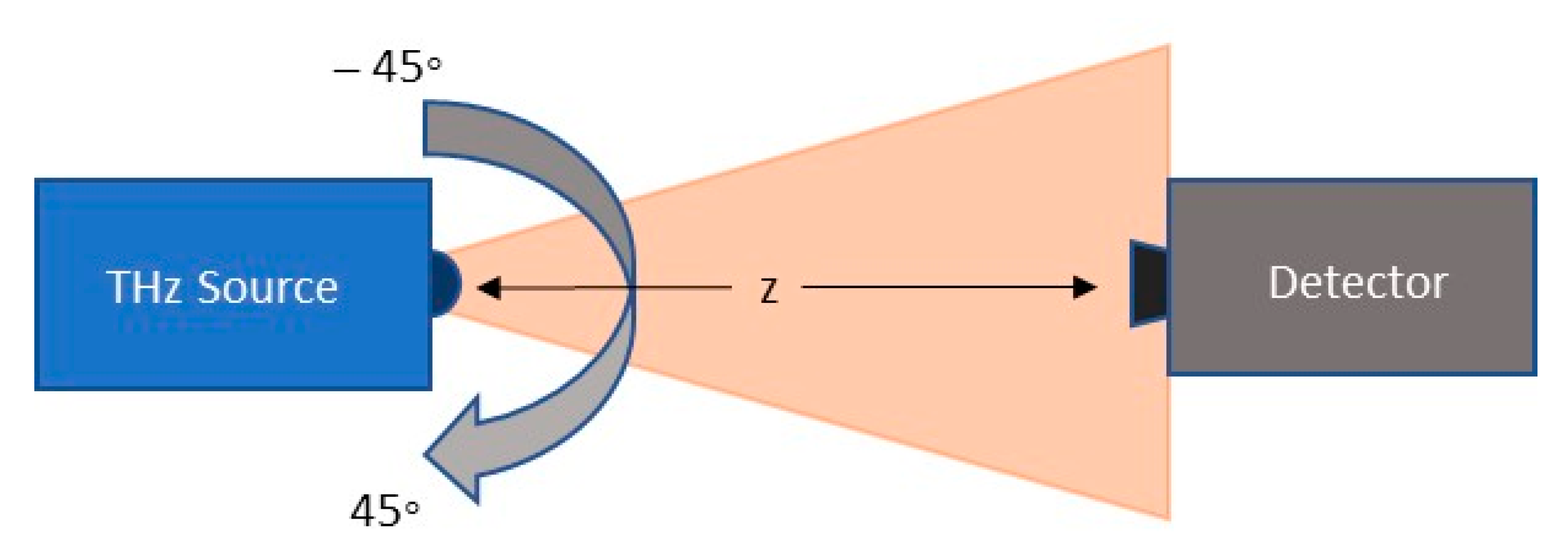


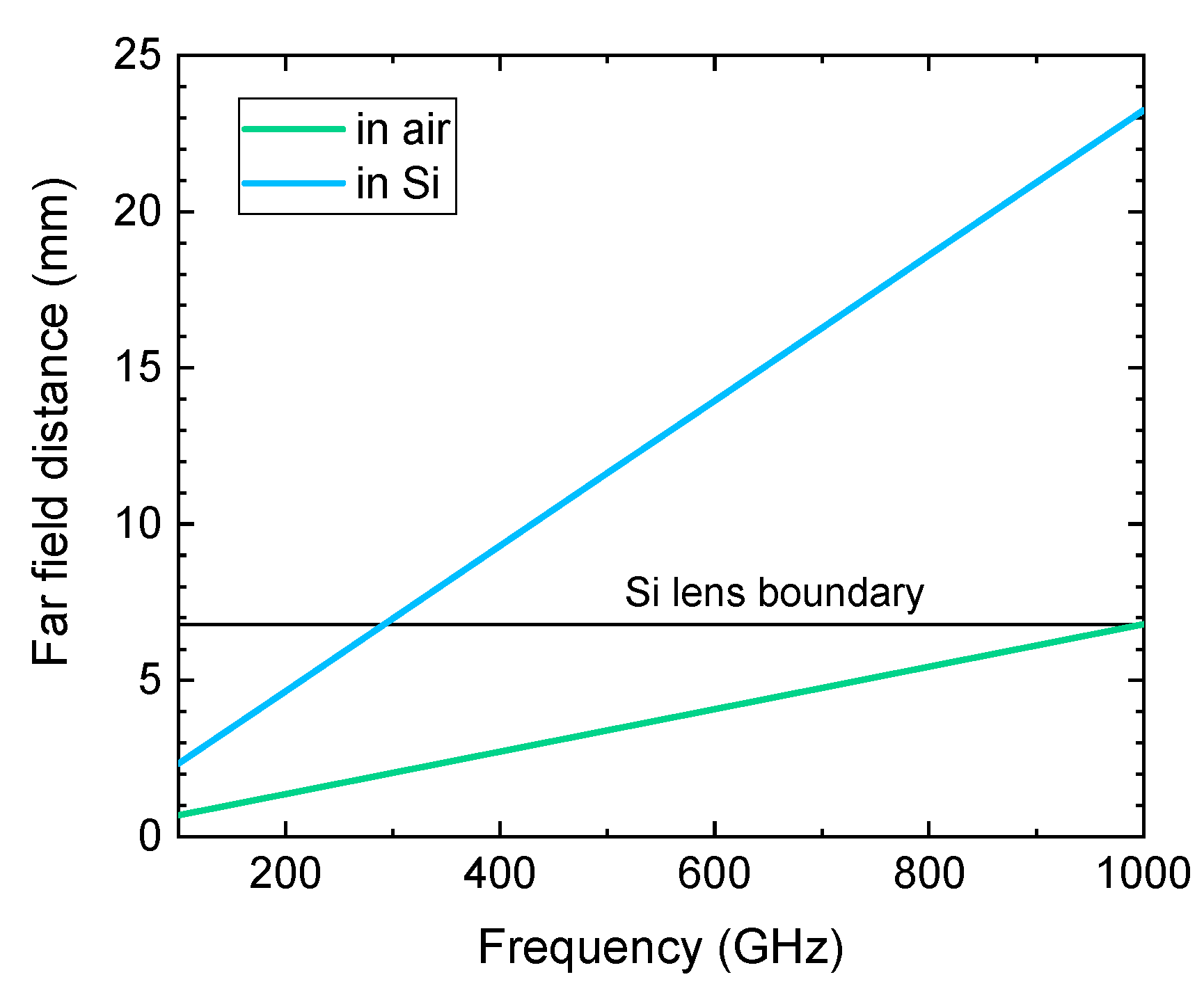
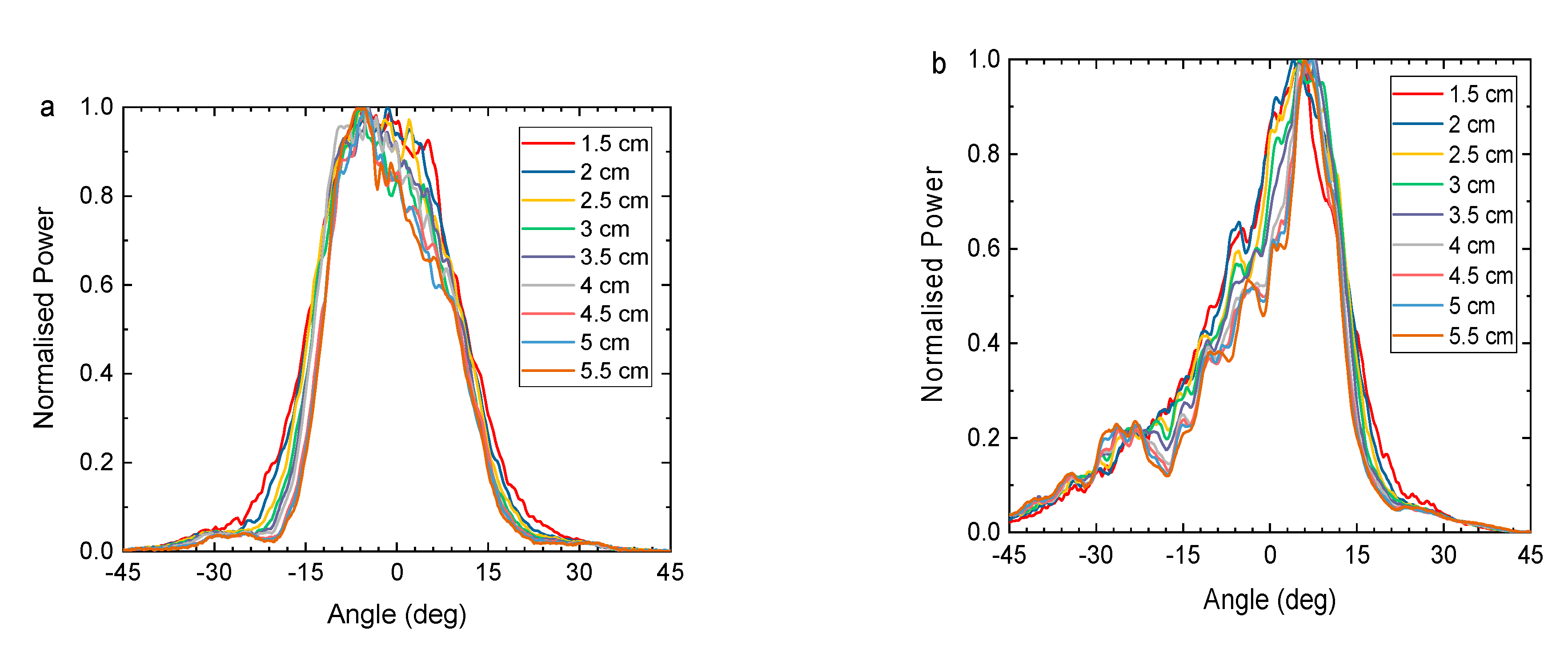
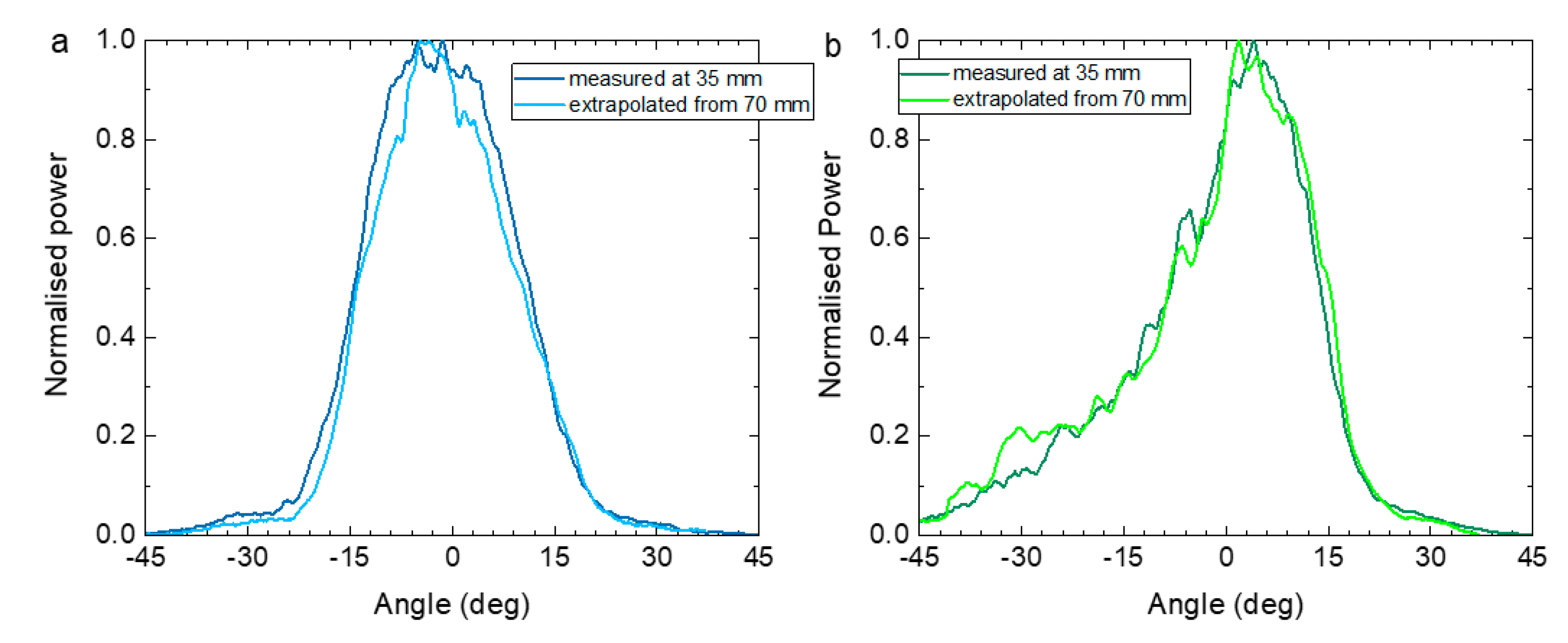
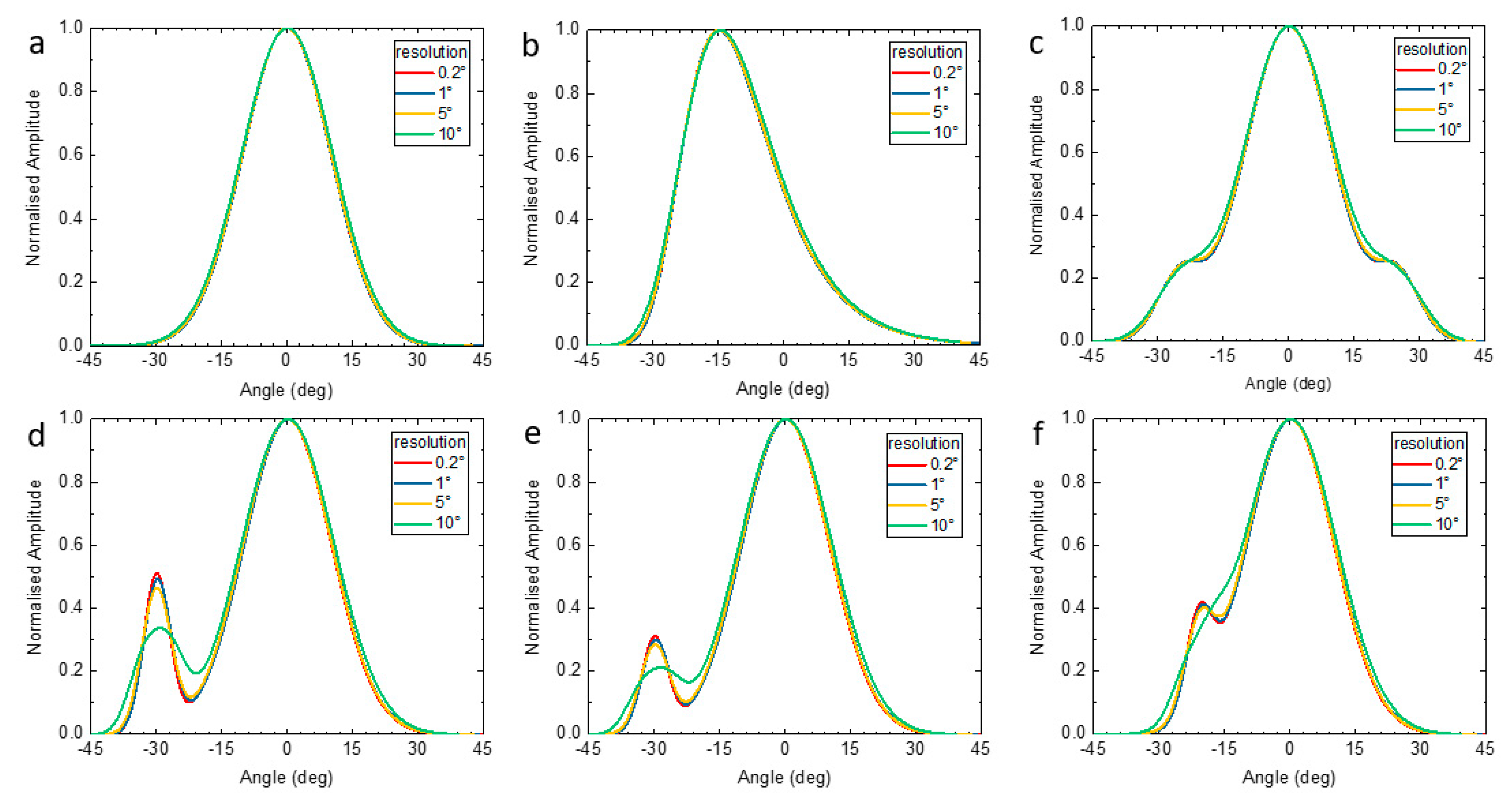
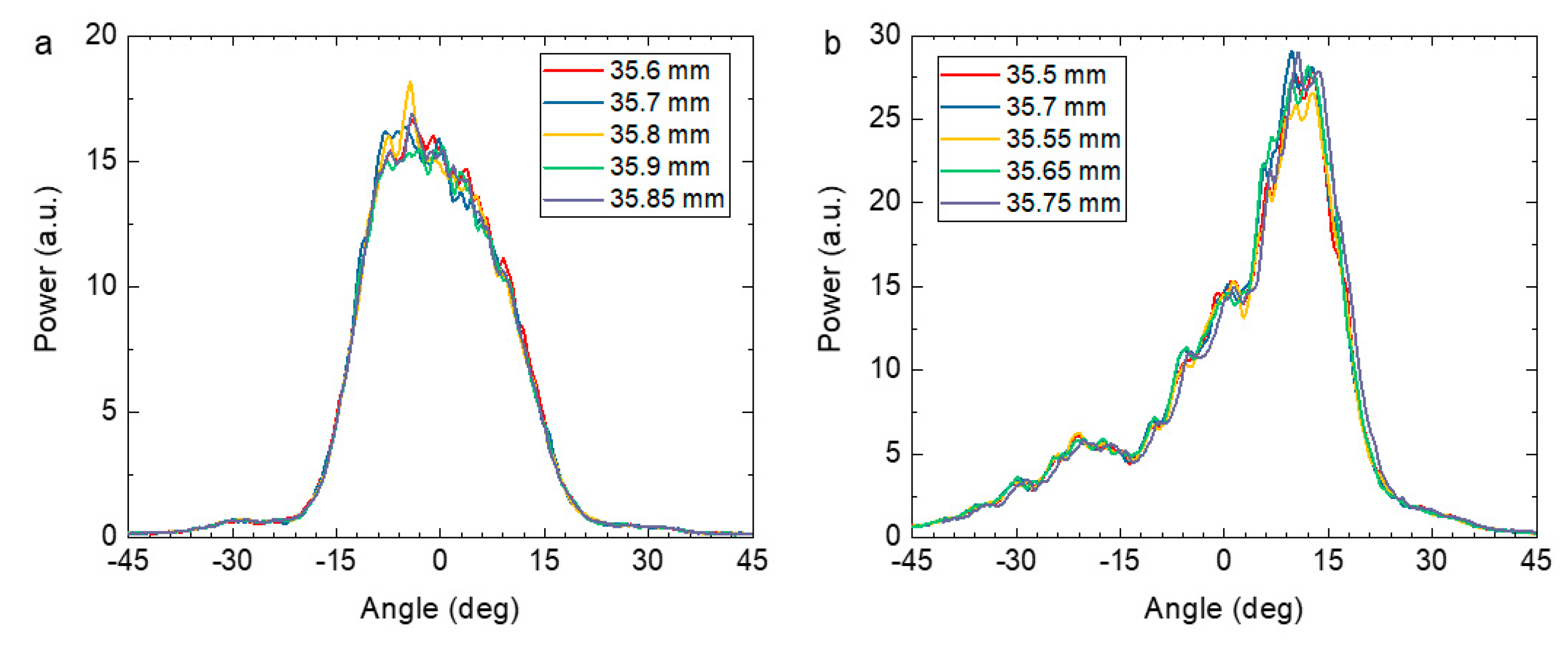

Publisher’s Note: MDPI stays neutral with regard to jurisdictional claims in published maps and institutional affiliations. |
© 2021 by the authors. Licensee MDPI, Basel, Switzerland. This article is an open access article distributed under the terms and conditions of the Creative Commons Attribution (CC BY) license (http://creativecommons.org/licenses/by/4.0/).
Share and Cite
Smith, J.; Naftaly, M.; Nellen, S.; Globisch, B. Beam Profile Characterisation of an Optoelectronic Silicon Lens-Integrated PIN-PD Emitter between 100 GHz and 1 THz. Appl. Sci. 2021, 11, 465. https://doi.org/10.3390/app11020465
Smith J, Naftaly M, Nellen S, Globisch B. Beam Profile Characterisation of an Optoelectronic Silicon Lens-Integrated PIN-PD Emitter between 100 GHz and 1 THz. Applied Sciences. 2021; 11(2):465. https://doi.org/10.3390/app11020465
Chicago/Turabian StyleSmith, Jessica, Mira Naftaly, Simon Nellen, and Björn Globisch. 2021. "Beam Profile Characterisation of an Optoelectronic Silicon Lens-Integrated PIN-PD Emitter between 100 GHz and 1 THz" Applied Sciences 11, no. 2: 465. https://doi.org/10.3390/app11020465





